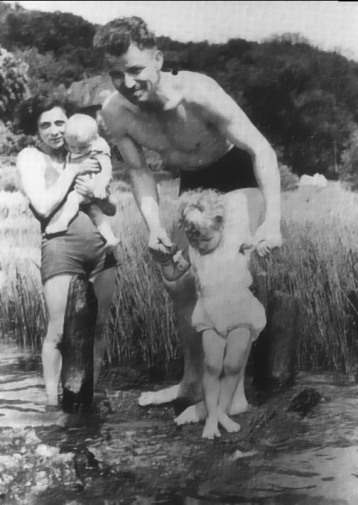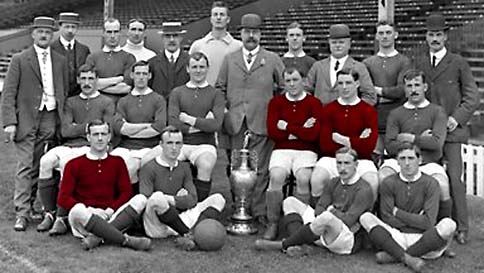Do you remember August Landmesser?
Do you remember what happened to the mild mannered card carrying Nazi? Well, Romeo, or rather August, found his Juliette, or rather Irma:
Irma was Jewish, but handsome Aryan August proposed to her without hesitation. She accepted without hesitation.
In the summer of that year of 1935, though, disaster befell them. They found out, that Irma, according to the “Nürnberger Gesetze, the Nüremberg Race Laws”, was formally and legally classified as a Jew. August was not a Jew and for this reason, he would not be allowed to marry her.
When his engagement to a Jew was formally discovered, August was immediately expelled from the Nazi Party:

Despite this rather unpromising beginning, August and Irma put in an application to marry in their home town of Hamburg. Their application was denied under the Nüremberg Race Laws, which had come into law only a very short time previously.
To cement the couple’s love, however, August and Irma’s first daughter, Ingrid, was born in October of 1935:
On June 13th 1936, August attended the launching of a new ship at Hamburg in the Blohm und Voss shipyards. He decided not to “Seig Heil!” or “Heil Hitler!” with all the rest, but to keep his arms firmly folded. It could not have been worse timed:
The ship was a training ship, the Horst Wessel, and was named after the Nazi Party’s greatest ever martyr. Men went into battle everywhere singing his happy song:
Furthermore, it was a naval vessel for the Kriegsmarine, the German Navy:
The Führer himself was the man smashing the champagne on the bow of the ship just before it slid off down the slipway into the water. Adolf, positioned directly opposite August Landmesser, may actually have seen his defiance. And even if he did not see August, such a high quality photograph could not have hidden August’s defiance in the middle of such a storm of “Seig Heil!” and “Heil Hitler!” salutes.
By 1937, though, August Landmesser had had enough. He attempted to flee northwards to Denmark with his family and leave Germany for ever. At the border, he was quickly arrested and eventually charged with “dishonoring his race,” or “racial infamy”, under the “Nürnberger Gesetze, the Nüremberg Race Laws”, mentioned above:
Just one year later, in July of 1938, because of an apparent lack of evidence, August was cleared of all crimes, but a suspicious Third Reich ordered him to have no further contact with Irma. In addition, August was given a severe warning that punishment would surely follow if he ever dared repeat any of the offenses.
For August, of course, this was completely impossible. How could he just abandon the love of his life? How could he give up his wife? The mother of his darling little daughter, Ingrid?
August ignored completely the demands of the Nazis.

Only a month later, in August of 1938, August was arrested again and put on trial. Not surprisingly, he was found guilty of all charges and received a sentence of hard labour for thirty months in a concentration camp. August was destined never to see the love of his life ever again. He had seen his darling wife and child for the last time.
It was easy now for the Gestapo to arrest Irma as a new law had been quietly added to the Nazi Statute Book. It required the arrest of all Jewish wives in the case of a man “dishonouring the race,”
Irma was duly imprisoned by the Gestapo who was by now heavily pregnant with a second child. In prison, Irma gave birth to a second daughter, Irene. Irma was then transferred to an all-women’s concentration camp almost straight after the birth. In later months, she was sent to various other prisons and concentration camps,
In 1942, Irma was taken to a euthanasia centre at Bernburg.
During the course of the war, a total of 9,384 sick and handicapped German people were to be murdered there. Around 5,000 prisoners from concentration camps were also murdered there. The doctors’ method of choice was carbon monoxide poisoning in a gas chamber.
In charge of this sickening establishment was Irmfried Eberl, who masqueraded as “Dr. Schneider” outside the walls. He was so promising as a genocidal monster that he became the first Kommandant at the Treblinka Extermination Camp, and made sure the place was in good working order with no problems. He must have been a little disappointed, though, that Treblinka missed the Million Total, with a mere 900,000 Jews killed there. “Dr. Schneider” was arrested in January 1948, but then hanged himself to avoid coming to trial. It must be said, though, he was a rather unimaginative man:
When Eberl’s colleague, Heinrich Bunke, was put on trial, he was initially given four years imprisonment for killing 11,000 people, but this was reduced on appeal to three years as his guilt could only be proved in 9,200 murders. Both Eberl and Bunke were firm supporters of Joseph Goebbels and his clearly stated attitude towards the treatment of the mentally ill .As he wrote so memorably in his diary:
“Discussed with Bouhler the question of the silent liquidation of the mentally ill. 40,000 are gone, 60,000 must still go.”
In actual fact Dr Goebbels aimed at the round figure of 100,000 killed by 1945, but he only managed a rather poor 70,000. Most of them were Germans. Most of them were children.
One of these victims, sadly, was Irma Eckler. And by the time that she died, August too was dead. He had been due to be released from the concentration camp system in the spring of 1941, but alas, he did not live to see that day.
August and Irma had two daughters, Ingrid and Irene. Both of them survived the Second World War, and outlived the Third Reich, even if, their parents did not.
The younger of the two daughters, Irene, has, in actual fact, documented the story of her family. She published her book in both German and English language versions, and it is now in its second edition. It is called “A Family Torn Apart by “Rassenschande”, and the full author name is Irene Eckler. The ISBN number is ISBN 3-9804993-2-4.
It is a moral tale worth reading in more detail. And it just goes to prove. Love DOES conquer all.











































